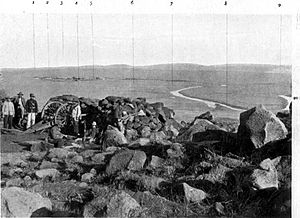Battle of Colenso
| Battle of Colenso | |||||||
|---|---|---|---|---|---|---|---|
| Part of Second Boer War | |||||||
 Battlefield of Colenso, from the Rooiberg, on the Boer right 1 General Louis Botha’s Commando 2 Boksburg Commando 3 Village of Colenso 4 Krugersdorp Commando 5 Wakkerstroom Commando 6 Ermelo Commando 7 Swaziland Police 8 Ermelo Commando 9 British Camp, Chievely 10 Tugela River |
|||||||
|
|||||||
| Belligerents | |||||||
|
|
|
||||||
| Commanders and leaders | |||||||
| General Sir Redvers Buller | General Louis Botha | ||||||
| Strength | |||||||
| 14,000 infantry 2,700 mounted troops 44 guns |
4,500 | ||||||
| Casualties and losses | |||||||
| 143 killed 755 wounded 240 missing 10 guns captured |
8 killed 30 wounded |
||||||
The Battle of Colenso was the third and final battle fought during the Black Week of the Second Boer War. It was fought between British and Boer forces from the independent South African Republic and Orange Free State in and around Colenso, Natal, South Africa on 15 December 1899.
Inadequate preparation and reconnaissance and uninspired leadership led to a heavy, and in some respects humiliating, British defeat.
Shortly before the outbreak of the war, General Sir Redvers Buller was dispatched to South Africa at the head of an Army Corps, and appointed Commander-in-Chief of all British forces in South Africa. On arrival, he found British garrisons besieged on widely separated fronts, with limited communications between the fronts. Having detached forces under Generals Lord Methuen and Gatacre to the western and central fronts, Buller assumed command of his largest detachment and proposed to lead it to the relief of a besieged British force in Ladysmith, in Natal.
On this front, the Boers had conducted some raids and reconnaissances into the southern part of the province, but in the face of a large British army, they had retired north of the Tugela River at Colenso and dug in there, blocking the road and railway line to Ladysmith. Buller originally intended making a flank march to cross the Tugela at Potgieters Drift 80 kilometres (50 mi) upstream of Colenso. On hearing that Gatacre and Methuen had been defeated at the battles of Stormberg and Magersfontein, Buller felt he needed to relieve Ladysmith as soon as possible and resume overall command of the forces in South Africa, and was worried that a move to Potgieters would put him out of telegraph communications with the rest of South Africa. He also lacked wagons and draught animals, and feared that a defeat at Potgieters Drift would leave his force isolated and trapped. He decided to make a frontal assault at Colenso after two days' artillery bombardment, beginning on 13 December.
...
Wikipedia
